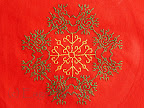Hello Readers,
It is that time of the year when most of us like to mail out cards wishing family and friends, even if we may not do it on a regular basis. E-cards are convenient, but there is a charm in sending an actual card. It is something that people proudly display in their houses and hold on to, for a long long time.
This year, why not make the Holidays extra special by embroidering your favorite designs on your greeting cards? Take a look at the designs in this post. You can embroider something simple in a short time or you can create something really really stunning if you have an hour or so to spare.
.JPG) I have tried to keep the holiday colors in the cards - red and green. Three of the designs are in the Kasuti style. I began this project by embroidering on a piece of Aida fabric, which is stiff and can easily be mounted on to a card. It turned out quite well, but I like the embroidery better on the card itself.
I have tried to keep the holiday colors in the cards - red and green. Three of the designs are in the Kasuti style. I began this project by embroidering on a piece of Aida fabric, which is stiff and can easily be mounted on to a card. It turned out quite well, but I like the embroidery better on the card itself.I used two strands of cotton embroidery thread and it took me about twenty minutes or so to complete the design. Embroidering on cards is actually quite simple. It will help if you punch-in the design with a needle before you begin.
This was done using rayon thread. I liked the rayon thread better for this project.
.JPG) I kept my favorite for last! I borrowed this design from a Chikankari design book, and used running stitch and back stitch to cover the design. It took me about 45 minutes to complete this piece.
I kept my favorite for last! I borrowed this design from a Chikankari design book, and used running stitch and back stitch to cover the design. It took me about 45 minutes to complete this piece.And finally here's wishing you all! You can click here for a bigger image.

.JPG)
.JPG)
.JPG)
.JPG)
.JPG)
.JPG)
.JPG)
.JPG)
.JPG)

.JPG)
.JPG)
.JPG)
.JPG)

.JPG)
.JPG)
.JPG)
.JPG)
.jpg)
.JPG)
-final-med.JPG)
-final-med.JPG)

.JPG)
.JPG)





.JPG)
.JPG)



.JPG)
.JPG)
.JPG)
.JPG)

.JPG)
.JPG)

.JPG)
.JPG)